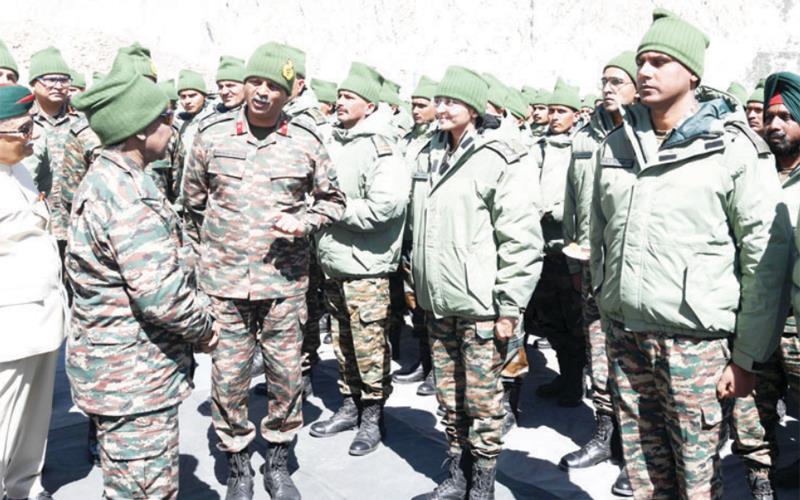In battle fatigues, Prez Murmu hails service of soldiers guarding Siachen
TNN Bureau. Updated: 9/27/2024 3:22:52 AM
Front Page

Leh: President Droupadi Murmu on Thursday became the first Indian woman president, and the third ever, to visit the Siachen base camp where she addressed the army’s forward deployed soldiers and hailed their bravery, commitment and dedication while serving on and defending the world’s coldest and highest battle ground.
The base camp is the gateway to the Siachen glacier, a 76-km river of slow-moving ice.
The presidential visit assumes significance as it comes in the 40th year of the Indian Army evicting Pakistani soldiers who had occupied towering heights in Siachen --- the army launched Operation Meghdoot on April 13, 1984, to clear them out and take full control of the strategic glacier.
Addressing the soldiers at the base camp, the President, who was in battle fatigues, said, “Since the commencement of Operation Meghdoot, the brave soldiers and officers of the Indian armed forces have ensured the security of this region. They face severe weather conditions. In difficult situations like heavy snowfall and minus 50 degrees temperature, they remain deployed at the front with full devotion and vigilance.”
Army chief General Upendra Dwivedi accompanied the President, who is also the Supreme Commander of the Armed Forces.
The soldiers present an extraordinary example of sacrifice in protecting the motherland, she added. Murmu paid tribute at the Siachen war memorial that honours the sacrifices of soldiers and officers who have been killed in action since the army launched Operation Meghdoot.
Presidents Ram Nath Kovind and APJ Abdul Kalam visited Siachen in 2018 and 2004, respectively.
Almost 80% of posts on the glacier are located above 16,000 feet, with Bana towering above the rest at 21,753 feet. Murmu’s visit came five months after defence minister Rajnath Singh visited the glacier and carried out a security review.
The Indian Army’s control of the glacier prevents the Pakistani army from linking up with the Chinese People’s Liberation Army and posing a threat to Ladakh. It acts as a wedge between the Shaksgam valley under China’s control and Baltistan, which is occupied by Pakistan.
Guns have been silent on the glacier since the November 2003 ceasefire between Indian and Pakistan, but weather and terrain have continued to claim lives. On the glacier, soldiers deal with altitude sickness, high winds, frostbite and temperatures as low as minus 60 degrees Celsius.
The death of 10 soldiers in an avalanche at Siachen in February 2016 put the spotlight on the harsh conditions faced by troops as well as the glacier’s strategic importance to India. Among them was Lance Naik HanamanthappaKoppad who died after battling for his life for more than a week after an avalanche struck an army post at 20,500 feet.
In January 2023, the army for the first time deployed a woman officer, Captain Shiva Chouhan, at the world’s highest battleground. Soldiers serve a three-month stint in the frozen landscape.
India spends ₹5 to ₹7 crore daily to guard the glacier.
The army currently occupies dominating positions on the Saltoro ridge with Pakistani posts located 3,000 feet below.
Several rounds of talks between India and Pakistan on demilitarising the Siachen glacier --- an old sore in bilateral ties -- have failed with Islamabad refusing to authenticate troop positions on the ground.